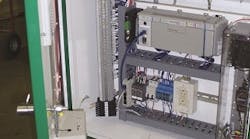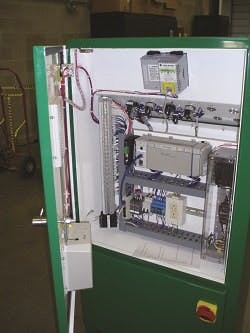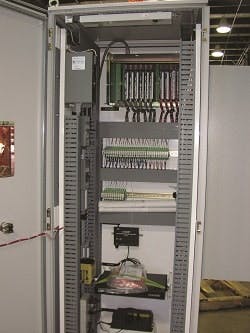Jim Montague is the executive editor for Control, Control Design and Industrial Networking. Email him at [email protected] or check out his Google+ profile.
Increasing demands for big data must be fed by more I/O points, more-capable PLCs and larger SCADA systems, while at the same time many control rooms and centralized cabinets are shrinking or disappearing. Both of these factors mean larger, more complex and more widely distributed control panels, but these added responsibilities don't mean they can't be well-dressed and well-suited to fit their available space.
Fortunately, system integrator and electrical manufacturer Easter-Owens in Arvada, Colo., is acutely aware of these needs, and so they design and manufacture customized control panels, consoles, switchgear and prefab structures outfitted with power, motor control centers (MCCs) and other controls, variable frequency drives (VFDs), networking and related equipment. Their motto is: "If you can think it, we can build it."
"Our customers want to automate their applications, and so they need additional I/O components," says Ken Schultze, engineering manager at Easter-Owens. "As a result, the mix of our projects is changing. We're seeing larger PLC systems and more I/O, which have increased by about 50% in recent years. This is especially true in the oil and gas industries, which are investing in compressors and pipelines to capture and transport natural gas and oil."
The components in Easter-Owens' Computrol control panel will manage a canning production line.
Source: Easter-Owens
Established in 1955, Easter-Owens provides customized solutions in the overall application areas of industrial controls, power distribution, metal fabrication and detention systems. Because it's completely involved in managing each client's project from start to finish, the company reports it can design, manufacture and implement solutions tailored to their specific applications, which improves on standard products that don't always meet fit, form or functional needs. It also meets regulatory requirements of ISO 9001:2008, and offers UL listings for most solutions and applications.
"We have grown significantly since 1955, but we continue to operate with the same small, family-owned philosophy," says David Easter, CEO and president of Easter-Owens. "Consequently, we're committed to providing the highest quality solutions available through our responsiveness and commitment to the needs of our customers."
[javascriptSnippet]
Besides its MCCs and VFDs, Easter-Owens also integrates PLCs, HMIs, instrumentation, lighting and other components into its panels and enclosures. These structures house controls for mining equipment, snow-making pumps, airport lighting, purge units, water-treatment facilities and other process and discrete applications.
"We have an extremely varied customer base, but the process person in charge of an application or other 'idea guys' often don't know controls and automation," Schultze explains. "That's where our expert team comes in to design everything from the PLCs to the panel. We ask what they've got now, look at any drawings or concept diagrams, and ask what they want to accomplish."
To build its customized equipment from scratch, Easter-Owens' panel-building department starts by designing job-specific layouts that precisely meet the requirements of all the internal controls and other components that the client needs. This is an improvement over standard panels, which frequently force other builders to squeeze their designs into enclosures that are too small, or size up to larger ones that waste space.
Another primary advantage for Easter-Owens is that it can design and almost immediately cut and punch metal for a project. "We can draw in CAD, and then transfer patterns to our new CNC machines. So, where it used to take all day to punch holes for a panel, we now can do it in five minutes," Schultze says. "This equipment also enables us to manufacture better and more-elaborate panels."
Easter-Owens employs air-conditioning in this PLC enclosure, which will serve in a valve control application.
Easter-Owens uses Autodesk's AutoCAD Inventor and AutoCAD Electrical software for its designs, and then carries them out with their Finn Power CNC press and Trumpf 50,000-W laser CNC cutter. "These machines save us a lot of revenue because previously we had to use a single-station press, and it took more time to set up its x- and y-axes, or even drill holes after assembly," Schultze adds.
The components in Easter-Owens' panels consist of all the usual components, including PLCs, 24 Vdc power, Ethernet switches, interface modules, I/O terminal blocks, and HMIs with pushbuttons or touchscreens on the door. "We can reproduce any type of HMI or interface that's needed, and draw pumps, fans or other devices on screen using imported graphics and functional instructions."
Schultze reports that Easter-Owens also saves time on its PLC panels by collaborating with its suppliers such as Phoenix Contact to develop more creative and capable interfaces between its PLCs and field devices. "Most PLCs aren't wired to the field, so they traditionally use interface terminal blocks mounted on circuit boards to monitor field I/O points," Schultze explains. "In the past, this meant bigger combinations of PLCs, blocks and interface terminals, which took up a lot of real estate and took more time to install. Now, we have better terminal blocks, jumpers and accessory choices.
"Phoenix Contact makes preconfigured cables that can work with all types of I/O coming in, as well as with established PLCs from Rockwell Automation and Siemens. We're not taking out the traditional middle block, but just using a more sophisticated interface. Previously, terminal blocks were larger, clunky and harder to use, but now our preconfigured blocks and cables have smarter designs that we can use to save time, space and costs. For example, we recently used Phoenix Contact's UT Series terminal blocks for a PLC panel at a wastewater treatment plant. This enclosure had a typical back panel inside with mounted components, including a Rockwell Automation PLC, but the new blocks made it easier to wire and install, and let us achieve faster, better control functions."








